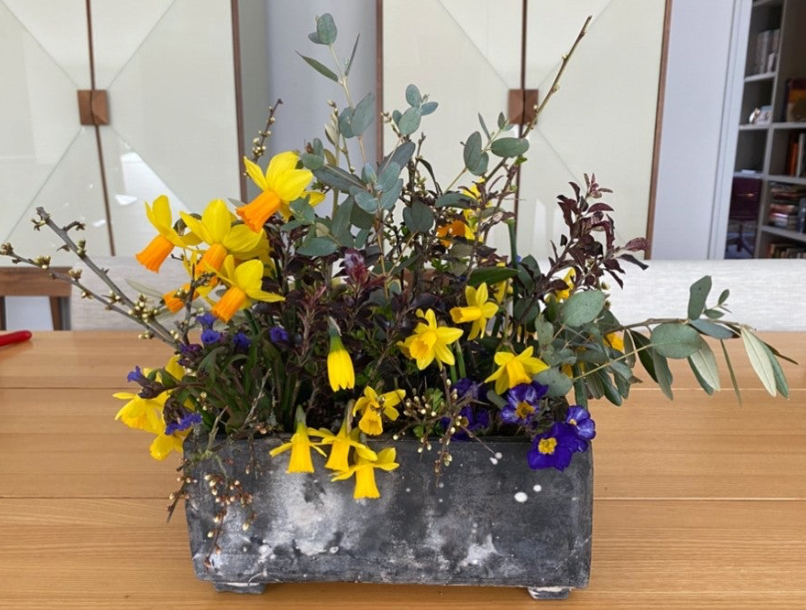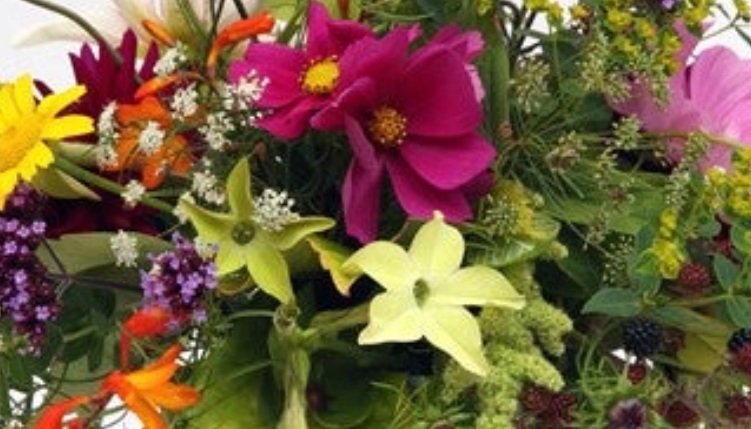
How to plan and grow a continuous crop of cut flowers this year
SEO Space


As we move into Spring, we’re casting our minds forwards to the promise of warmer weather and a much more productive period for the garden. It feels as if it’s been an especially long, dark, wet Winter this year, and with all the mud around in January and February it felt at times impossible to think that the ground could once again be covered in lush grass, plants and flowers. But, sure enough, Spring does eventually arrive and, once again, nature surprises and delights, prompting us to start thinking about what we can achieve with our garden this year. One thing that’s been on our list of things to do for a while now is to grow more cut flowers.
But why? Firstly, I restrict the colour palette in my herbaceous borders and, in contrast, I love bowls of chorus girl colours in the house – my cutting garden gives me licence to grow and enjoy these sprays of colour. Flowers – even supermarket ones – are costly and tend to be uniform varieties with rigid stems and a long shelf life. Like so many things, it is better for the environment to grow and cut your own: they provide food and sanctuary for those essential pollinators and we can cut down on the pollution generated by growing flowers under glass and transporting them around the world. And they smell better!
Alstroemarias
Fleshy-rooted perennial.
Semi-circular support or one-ring herbaceous support
Cosmos and nicotiana
Annuals grown from seed.
Wonderful cut flowers with a long flowering period but their stems tend to be wayward – hold them back with a semi-circular support
Dahlias
Tuberous rooted perennials – may need a winter mulch.
Depending on the variety: one-ring herbaceous support or semi-circular support; stake the larger varieties with 3 or 5 stakes and twine; use broad bean supports between rows of dahlias
Delphiniums and larkspurs
A clump-forming perennial grown from seed or basal cuttings in spring.
The taller, heavier spikes of delphiniums benefit from being staked individually as the heads are prone to snap off in high winds; the more dainty larkspurs can be happily contained by a semi-circular support
Peonies
Fleshy-rooted, clump-forming perennials – in contrast to dahlias, peonies hate to be mulched, they like to live just below the surface of the soil.
Of all the flowers, whether in the border or cut flower garden, that need support, peonies are the number one! Get a peony support set around the root ball as you plant it and disturb them both as little as possible. Now is the time to get peony supports on before they push up those lovely deeply-cleft leaves.
Fiona Porter of Cotswold Country Flowers grows wild flowers in her garden on the edge of the Cotswolds, which she supplies to individuals and businesses local to her home in Stroud. All of her flowers are natural, sustainable and wild-life friendly. They’re freshly cut and conditioned so they will last longer and they smell wonderful!
She welcomes visitors to the garden for her flower-filled workshops and hosts pick-your-own days and open garden events.
We asked Fiona a number of questions that might help the amateur enthusiast:
How did you get started growing your own cut flowers? Where did you/do you get your inspiration?
I have always loved gardening and flowers although until I started my business 4 years ago it was just a hobby. Each year I religiously grew annual flowers from seed to brighten up and fill gaps in my borders – now I just do it on a bigger scale! My inspiration came from other growers of British flowers such as Sarah Raven, Georgie Newberry of Common Farm Flowers and Wendy Paul and Jo at Organic Blooms. I would not be where I am today without Flowers from the Farm. A 1000+ strong, supportive network of growers and florists who champion seasonal, scented, sustainable British cut flowers.
Do you need a lot of space to be able to grow a continuous crop of cut flowers? How should I plan out my plot?
The simple answer is no, you don’t need masses of space. It's amazing how much you can harvest from a 1m x 4m plot. My advice would be:
-
Don’t be too ambitious with the number of varieties you grow
-
Plan ahead
-
Keep succession sowing either directly into the soil (some do better this way) or in seed trays. I had cornflower and corncockle flowering in November from a late crop of direct sown seeds in July
-
Aim for a variety plant types e.g. bulbs and corms for spring, perennials for dependability, shrubs for foliage, hardy and half hardy annuals for prolificacy and colour, dahlias for late flowering focals
-
Plant flowers closely (from 15 -30 cm depending on flower)
-
Don’t be afraid to cut them!
Are there certain flowers that are less appealing to unwanted pests? And certain flowers that are better for bees and butterflies?
You have to take the rough with the smooth and know that there will be some losses from pests. However, by encouraging wildlife such as ladybirds to help deal with aphids, and birds, hedgehogs and toad habitats to keep on top of slugs and snails, you will be amazed how nature can do a good job for you. Allow parts of the garden to have long grass and weeds for mammals to sneak away and hide. Open, daisy-like flowers are more attractive to bees and butterflies than doubles or pompoms. Slugs and snails seem to love my larkspur but I do find beer traps work a treat. Sometimes you have to live with a few aphids before the ladybird larvae come into their own and do the hoovering for you. Carrot fly and/or wind/rock can be a problem for umbellifers. Good plant support and veggie mesh can help with this.
What are the essential pieces of ‘kit’ that I’ll need?
Must haves:
-
Plant supports – I have supports for almost all my flowers. It’s a bit like camping, pitch your tent for a force 8, just in case. Some flowers can get really tall e.g. ammi majus, helianthus, cosmos or bushy. It is really important that they keep growing straight up otherwise the flowers end up being blown, growing at strange angles and there is nothing more demoralising than finding your crop on the floor just as it is perfect to cut.
-
Correct items for seed sowing e.g. trays with module inserts, gravel trays, capillary matting, good quality peat free compost, vermiculite, perlite for various stages of seed propagation
-
Snips for cutting flowers
Nice to haves:
-
Greenhouse, cold frame, heated propagator, hoops and enviromesh, and fleece to provide some protection in the early stages
What are the main problems that I might encounter and how can I pre-empt them or deal with them when they arise?
At seed growing stage it is very easy to accidentally over water. It is a delicate balancing act (particularly when the seedlings are tiny) as you also don’t want the compost to dry out. However, it is easier to correct underwatering than it is to correct over watering. Water from underneath and using a small piece of capillary matting cut to size in a seed tray is useful, as this can be kept damp and provides enough moisture for the seedlings and encourages roots to grow down. Give them a good drink every few days rather than giving them a little every day.
Don’t allow plants to get pot bound. You have to allow plants to keep putting down their roots, whether that’s transplanting, potting on or planting out. If you impede them for too long they will sulk.
Keep cutting flowers, particularly annuals – their one purpose is to flower and set seed and die. It is important to keep cutting flowers before they set seed, after all, that is why you are growing them (for cutting). This will keep them flowering for longer!
When should I pick flowers – time of day, point of growth – to ensure they last in the vase and ‘come again’?
The ideal time is early in the morning when the flowers are fully hydrated. Alternatively, late in the evening. Don’t cut in the heat of the day as they are more likely to wilt. Cut stems on an angle and put them straight into a clean bucket of clean water. The flower should be showing colour or just starting to open but should not be fully open.
Is there anything else I can be doing to make them last longer in the vase?
After cutting, fill the bucket up to half full, remove all leaves below the water line and put the bucket of flowers in a cool and preferably dark place, such as a north facing garage for several hours or overnight. This is called ‘conditioning’ and it sets the flowers up for a good vase life. It is essential that both the bucket and vase/jug are scrupulously clean; bacteria are the enemy! When arranged in a vase, refresh the water regularly, and if possible snip the stems every couple of days.
My flowers always look dumped into the vase – can you give me some tips for arranging them?
I do not use floral foam for environmental reasons, and so use techniques that were used pre-floral foam. To create an open arrangement and if the vase is not glass (i.e., not see through):
-
Take a scrunched up ball of chicken wire.
-
Pop it into the vase/receptacle, if possible keeping the top a bit proud of the vase. This means you can angle stems outwards a bit and yet they can still be in water.
-
Secure to the edge of the vase with pot tape or similar.
-
Fill ¾ with water.
-
Start by creating the shape and structure that you want with foliage at different heights and angles. The added advantage is that the stems start knitting together and start to make the arrangement even more secure.
-
Then start adding your flowers. I like to put similar flowers in little groups much like you would find them in the garden.
-
Avoid having any flower head at the same level and make sure they are not all standing upright but are leaning out or even down. This creates a lovely natural look.
Don’t overthink what you are doing. Just enjoy being creative and don’t worry about ‘rules’. If you have a glass vase, a new gadget called a ‘flora guppy’ does a very similar job but it is clear, plastic, moldable and reusable.
What is your no.1 tip for anyone wanting to get started growing their own cut flowers?
Don’t take on too much at once. Gradually expand your growing space when you know you can manage both the growing, maintenance and cutting. Don’t forget to think about planting shrubs for foliage (as these take a few years to establish) and perennials. Most importantly, enjoy it even when things go wrong. Put any disasters down to experience and learning.
If you’d like further information on growing your own cut flowers, then (subject to Covid restrictions) Fiona runs cut flower growing workshops throughout the year at her home in Dursley, Gloucestershire. Visit her website for more information: https://www.cotswold-country-flowers.co.uk/growing-workshop
For more advice and inspiration for your English country garden, follow us on Pinterest: www.pinterest.co.uk/plantsupports
Follow us on Instagram: www.instagram.com/muntons_plant_supports
